- BDU & Uniforms
- Belts & Buckles
- Combat Boots
- Sweatshirts & Hoodies
- Infants & Kids
- Marine Corps PT Gear
- US Marine Ball Caps
- Boonie Covers
- Utility Covers
- Veteran Hats
- Beer & Shot Glasses
- Marine Corps Flasks
- Mugs & Tumblers
- Water Bottles
- Regiment Pins
- Weapons Pins
- Marine Corps Belt Buckles
- Marine Corps Gifts
- MRE & Survival Food
- USMC Challenge Coins
- USMC & EGA Patches
- Air Wing Patches
- Regiment Patches
- Unit Patches
- USMC Decals
- Rank Decals
- Unit Decals
- Auto Emblems
- Bumper Stickers
- Hitch Covers
- License Plates & Frames
- Bags & Packs
- Marine Corps Camo & Concealment
- Marine Corps Canteens & Hydration
- Marine Corps Gloves
- USMC Survival Gear
- Marine Corps Personal Protective Equipment (PPE)
- Marine Corps Pouches
- USMC Paracord & Rope
- Marine Corps First Aid
- Marine Corps Flashlights
- Military Manuals
- Military Chest Rigs
- Fixed Blade Knives
- USMC Folding Knives
- Less-Than-Lethal
- USMC Swords
- Rifle Accessories
- USMC Chevrons
- Marine Corps Gold Chevrons
- Officer Collar Devices
- USMC Medals
- USMC Ribbons
- Ribbon Mounting Bars
- Range Qualification Badges
- Dress Uniform Accessories
- Uniform Care
- Misc Uniform Items


USGI Vietnam Trip Wire – 2 Colors
$ 16.95
Description
Additional information.
The USGI Vietnam Era Trip Wire is a versatile, historical military tool.
Made in the USA, this unused, full spool wire is durable and practical. Initially used in the military for defense and traps, its modern applications are vast. Suitable for perimeter alarms, DIY snares, and securing gear, it adapts to various needs, embodying multifunctionality and reliability.
Its enduring design and construction ensure it remains an essential asset for tactical and practical applications, showcasing adaptability across eras.
USGI Vietnam Era Trip Wire Features
- Military Trip Wire
- OD and Yellow annealed wire
- Uses include: perimeter trip wire alarm, setting boundaries, DIY snares, shelter building support, securing gear and much more
- Fast Shipping!
- Made in the USA!
Related products
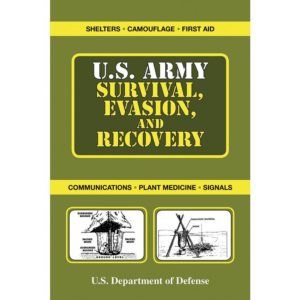
Military Survival Evasion and Recovery Manual

Military Style Weatherproof Notebook
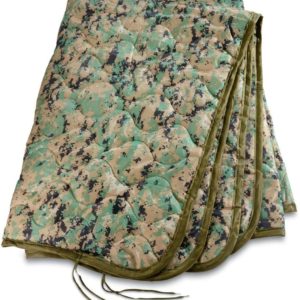
USMC Reversible MARPAT Woodland / Desert Poncho Liner (Surplus)
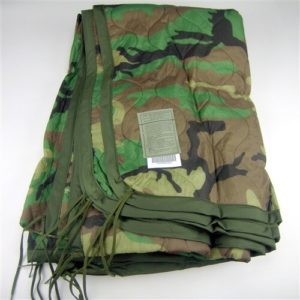
Govt. Issue Woodland Wet Weather Poncho Liner

- Military Collectibles
- Wars & Conflicts
- Vietnam Era
U.S. Army Vietnam Era Trip Wire
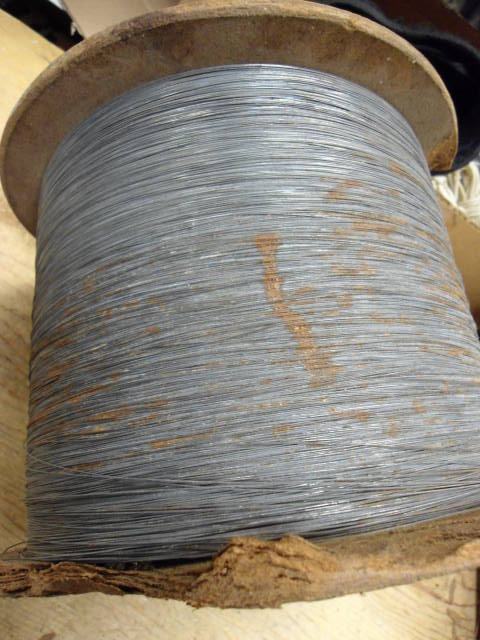
Write a Review

Have a Question?
- Create New Wish List
- Product Description
There are no reviews for this product, to write a review click here .
Related Products

U.S. Army Vietnam Era Sleeping Gear Carrier

U.S. Military Vietnam War Era Boonie Hat

Vietnam Era Vietnam Service Medal

US Military Canvas Stretcher/Litter

Vietnam Era Sunglasses with Case
JavaScript seems to be disabled in your browser. For the best experience on our site, be sure to turn on Javascript in your browser.
- Create an Account
- Compare Products
USGI Vietnam Trip Wire
USGI Tripwire 160 ft on each wooden spool.
2 each 40 ft yellow lengths and 2 each 40 ft OD lengths on each spool

- $ 0.00 0 items
- Belts & Pouches
- Tactical Vests
- Tac Holsters & Leg Rigs
- Mag And Ammo Pouches
- Misc Tactical
- ALL Scorpion OCP Products
- Shoulder Bags
- Canteens, Cups, and Covers
- Ropes & Straps
- Compass & Flashlights
- Sleeping Bags
- Mosquito Nets
- Wool Blankets
- Heat & Ration
- Military Manuals
- First Aid Supplies
- Camo Material
- Genuine US Military
- Molle Packs
- International
- Accessories
- Radio Pouches
- Clamps and Hooks
- Weapon Cleaning
- Everything Else
- Military Boxes
- Ponchos & Liners
- Embroidered Caps
- Boonie Hats
- Combat Caps
- Cold Weather
- Military Dress
- Veils, Scarves, And Shemaghs
- Jungle Boots
- Combat Boots
- Cold Weather Boots
- Dress Shoes
- Desert & Coyote Brown
- Shine And Polish
- Coats And Parkas
- Wool Clothing
- Field Jackets
- Flight Jackets
- Coveralls & Overalls
- Dress Uniforms
- Pistol Belts
- Cartridge Belts
- Dress Uniform Belts
- Combat Suspenders
- Trouser Suspenders
- Extra Belts
- Kids Vest & Flightsuits
- Kids Jackets
- Kids Shirts
- Long Sleeve
- US Military
- Foreign Military
- Helmet Accessories
- U.S. Bayonets
- Foreign Mil
- Ballistic & Leather
- Canvas & Nylon
- Plastic & Rubber
- Flight Helmets
- Flight Caps
- Helmet Parts
- Instruments
- Tag Accessories
- Bugles And Whistles
- Acu & OCP
- Morale/Hook & Loop Patches
- Foreign Flags
- US Gas Masks
- Foreign Gas Masks
- Bags & Accessories
- Practice Bombs
- Dummy Rounds
- Unusual finds
- 1-Only Items!
Vietnam Era Trip Wire Spool
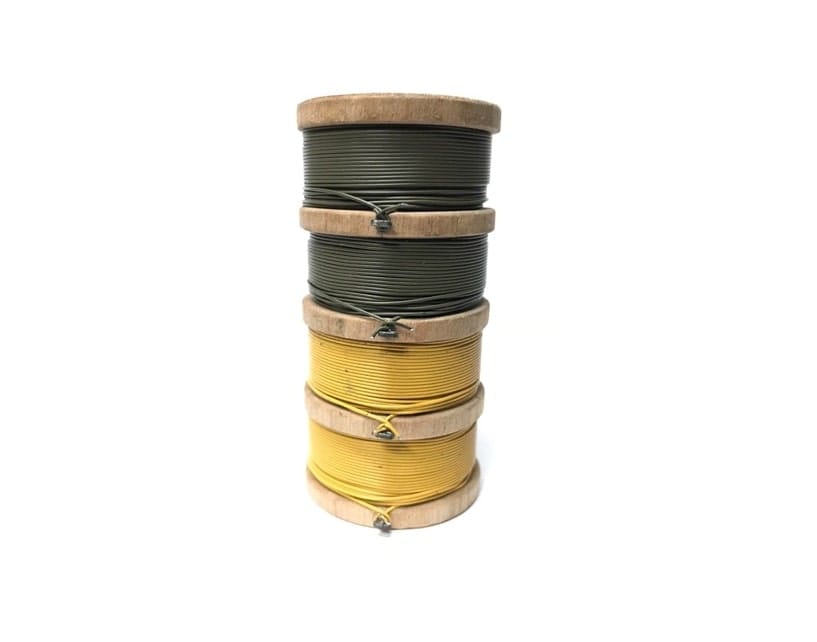
$ 14.95
Description
- Reviews (0)
NOS US Military Vietnam Era Trip Wire. The wooden spools show signs aging such as small chips, cracks, or discoloration from shelf storage.
Wooden spool has 4 rolls of wire, 2 olive drab 2 yellow.
Spool measures approx 1 3/8 in. diameter by 2 ¾ in. tall Each of the four sections of the spool has 160 ft of wire. Price is for 1 spool.
There are no reviews yet.
You must be logged in to post a review.
Related products

U.S. Mess Kit, Used
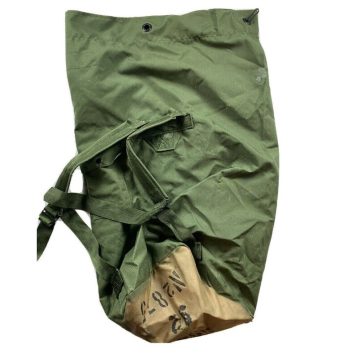
U.S. Military Duffle, Used Good Condition
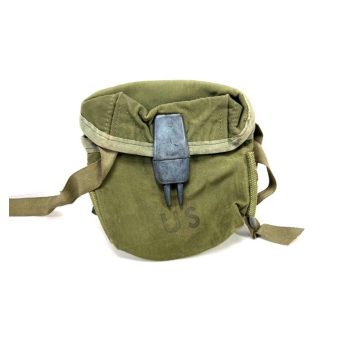
20rd M-16 Mag Pouch/nylon Used good condition
Product categories.
- Uncategorized (0)
- New Arrivals (29)
- Equipment (30)
- Instruments (8)
- Replica (6)
- US Milspec (4)
- Flight Caps (2)
- Flight Helmets (3)
- Headsets (6)
- Helmet Parts (9)
- Chute Gear (18)
- Foreign Mil (3)
- U.S. Bayonets (7)
- Commercial (1)
- U.S. GI (3)
- Mess Hall (3)
- Ballistic & Leather (4)
- Canvas & Nylon (6)
- Plastic & Rubber (1)
- Cartridge Belts (6)
- Combat Suspenders (17)
- Dress Uniform Belts (14)
- Extra Belts (2)
- Pistol Belts (15)
- Trouser Suspenders (1)
- Fatigues (25)
- Shirts (20)
- Dress Uniforms (18)
- Accessories (12)
- Cold Weather Boots (6)
- Combat Boots (10)
- Desert & Coyote Brown (6)
- Dress Shoes (3)
- Jungle Boots (6)
- Shine And Polish (5)
- Leggings (5)
- Msc Hats (8)
- Combat Caps (24)
- Embroidered Caps (19)
- Bandanas (5)
- Boonie Hats (29)
- Cold Weather (21)
- Military Dress (6)
- Veils, Scarves, And Shemaghs (8)
- Helmet Accessories (16)
- US Military (14)
- Foreign Military (11)
- Kids Jackets (5)
- Kids Pants (1)
- Kids Shirts (11)
- Kids Vest & Flightsuits (9)
- Coats And Parkas (9)
- Coveralls & Overalls (6)
- Field Jackets (6)
- Flight Jackets (6)
- Wool Clothing (9)
- Long Sleeve (4)
- Foreign (6)
- Gloves (12)
- Pajamas (7)
- Shorts (20)
- Underwear (18)
- Women's (17)
- 1-Only Items! (11)
- Unusual finds (35)
- Dummy Rounds (13)
- Extras (10)
- Practice Bombs (4)
- Badges (40)
- Brassards (6)
- Medals (28)
- Stamp Shop (5)
- Tag Accessories (3)
- Foreign Flags (4)
- US Flags (15)
- Bugles And Whistles (1)
- Posters (2)
- Acu & OCP (7)
- Morale/Hook & Loop Patches (12)
- US Patches (74)
- Bags & Accessories (19)
- Foreign Gas Masks (2)
- US Gas Masks (4)
- Ponchos & Liners (12)
- Clamps and Hooks (12)
- Everything Else (26)
- Slings (14)
- Ammunition (13)
- Duffle (16)
- Shoulder Bags (14)
- Ammo Boxes (27)
- Military Boxes (20)
- Camo Material (10)
- Camo Nets (4)
- Hydration (5)
- Accessories (29)
- International (8)
- Genuine US Military (19)
- Molle Packs (13)
- Ammunition (46)
- First Aid (14)
- Holsters (14)
- Radio Pouches (3)
- Wool Blankets (17)
- Hammocks (2)
- Mosquito Nets (6)
- Sleeping Bags (13)
- First Aid Supplies (16)
- Military Manuals (16)
- Heat & Ration (12)
- Rescue (10)
- Canteens, Cups, and Covers (49)
- Compass & Flashlights (14)
- Mess Kits (32)
- Ropes & Straps (29)
- Shovels (19)
- Weapon Cleaning (6)
- ALL Scorpion OCP Products (18)
- Misc Tactical (9)
- Belts & Pouches (24)
- Mag And Ammo Pouches (31)
- Tac Holsters & Leg Rigs (13)
- Tactical Vests (11)
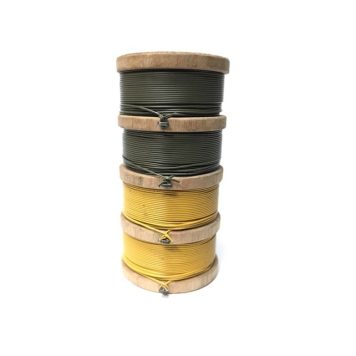
JavaScript seems to be disabled in your browser. For the best experience on our site, be sure to turn on Javascript in your browser.
- Create an Account
- Compare Products
New USGI Vietnam Trip Wire
Usgi tripwire.
160 ft on each wooden spool. 2 each 40 ft yellow lengths and 2 each 40 ft OD lengths on each spool.
Spool measures 1.5” Diameter by 2.75” long.

U.S. Government issued Trip / Snare Wire 160' Vietnam Era Emergency Survival
Write a review.

Military Depot
- Create Wish List
Description
United States Government issued trip wire from the Vietnam era. Full spool containing 160 feet.
Related Products

Government Issued U.S. Military Pistol Lanyard

U.S. Government Issued Army Wool Scarf
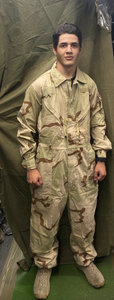
Mechanics Cold Weather Coveralls - Three Color Desert - U.S. Government Issued

Mechanics Cold Weather Coveralls - Woodland - U.S. Government Issued
Newsletter signup.
- Share full article
Advertisement
Supported by
U.S. WILDS HIDE SCARS OF VIETNAM
- Dec. 31, 1983
Living a solitary life in Washington's wilderness, the war veterans are almost never seen. But a few are there, shunning society and living by the skills they learned in the jungles of Vietnam, according to Randy Fisher, the state veterans' affairs director.
State officials call them ''trip- wire'' veterans, recalling the phrase American servicemen used for the deadly unseen traps the Vietcong laid along trails to snare and maim G.I.'s on patrol. It also applied to certain soldiers who developed a knack for finding those traps and dismantling them.
Now state officials say a very small percentage of veterans who, unable to cope with the stress of their war memories and the disapproval they faced on returning home, have disappeared into the woods to live the only way they felt comfortable.
''Out there in the woods are wonderful, loving people who just want to be left alone, who are saying, 'I don't want a world where I am going to be spit on and have tomatoes thrown in my face,' '' said Bruce Webster, a psychologist in Port Angeles, Wash., who works with veterans. 85 Return to Society
About 85 trip-wire veterans have re-entered society since the State Veterans Affairs Department began a program to reach them, said Mr. Fisher, director of the department. He said he did not know how many more there might be.
With a $100,000 grant from the state, Mr. Fisher and Mike McWatters, a private consultant who says he hid for two years in New York's Adirondacks after returning from the war, began the counseling service in August.
Last summer Mr. McWatters did a survey to determine how many of the state's 100,000 veterans from the Vietnam era needed counseling but lacked programs. He found about 1,000, and a number of them were veterans whose existence resembled that of 19th-century mountain men.
Marvin, a 33-year-old former marine who did not want his last name published, says he lived as a woodland shadow off and on for 10 years, tracking and trapping animals, wearing buckskin clothes, sleeping in caves and hollow tree stumps.
He was one of several trip-wire veterans interviewed by The Tacoma News Tribune for a series of articles this week.
''There's a lot the public don't know, and probably will never know, about what happened in 'Nam,'' he said. ''The only job skills I have are those that might be useful to a hit man for the Mafia.''
Marvin said he spent four years in Vietnam as a Special Forces scout before being wounded in 1971. When he returned to the United States he headed for the woods, holing up in Colorado, Wyoming and Montana and ending up in Washington. He avoided all human contact, he said, because ''I couldn't stand to be touched.''
He said he suffered from paranoia and nightmares. Since he sought counseling a year ago, Mr. Webster has diagnosed him as a victim of post-traumatic stress disorder, a psychological illness in which symptoms appear years after the event that caused them.
Bill Maier, 35, says he was also a trip-wire veteran. The former marine, who saw heavy combat in Vietnam, said he had sought refuge in the woods from his recurring nightmares.
'Afraid of Everything'
But his sanctuary became his torment, for the isolation became too much. ''I became afraid of everything,'' he said. ''I had to get out. Everything was closing in on me.''
Mr. Maier sought help from Mr. Webster, his former high school track coach, and now says, ''I feel I'm getting well again.'' He spends much of his time going back to the woods to find other trip-wire veterans and to urge them to seek counseling.
Trip-wire veterans are not ''loonies,'' Mr. Fisher said. They are troubled and confused men who cannot come to terms with their post-traumatic stress disorder. In a demanding and complicated society, they cannot control their feelings, he said, but in the wilderness, where they know they can survive by their wits, they feel secure.
''I know of one vet who went into the woods naked, came back out later with full leathers,'' Mr. McWatters said, referring to animal hides for clothing, ''had gained 40 pounds and was armed'' with weapons he made.

USGI Trip / Snare Wire 160' Vietnam Era Emergency Survival › Customer reviews
Customer reviews.

USGI Trip / Snare Wire 160' Vietnam Era Emergency Survival
Customer Reviews, including Product Star Ratings help customers to learn more about the product and decide whether it is the right product for them.
To calculate the overall star rating and percentage breakdown by star, we don’t use a simple average. Instead, our system considers things like how recent a review is and if the reviewer bought the item on Amazon. It also analyzed reviews to verify trustworthiness.
Top positive review
Top critical review
There was a problem filtering reviews right now. Please try again later.
From the united states.

There was a problem loading comments right now. Please try again later.

- ← Previous page
- Next page →
Questions? Get fast answers from reviewers
- Amazon Newsletter
- About Amazon
- Accessibility
- Sustainability
- Press Center
- Investor Relations
- Amazon Devices
- Amazon Science
- Sell on Amazon
- Sell apps on Amazon
- Supply to Amazon
- Protect & Build Your Brand
- Become an Affiliate
- Become a Delivery Driver
- Start a Package Delivery Business
- Advertise Your Products
- Self-Publish with Us
- Become an Amazon Hub Partner
- › See More Ways to Make Money
- Amazon Visa
- Amazon Store Card
- Amazon Secured Card
- Amazon Business Card
- Shop with Points
- Credit Card Marketplace
- Reload Your Balance
- Amazon Currency Converter
- Your Account
- Your Orders
- Shipping Rates & Policies
- Amazon Prime
- Returns & Replacements
- Manage Your Content and Devices
- Recalls and Product Safety Alerts
- Conditions of Use
- Privacy Notice
- Consumer Health Data Privacy Disclosure
- Your Ads Privacy Choices
- Terms of Use
War News | Military History | Military News
Vietnam war traps: 9 viet cong booby traps that defined the vietnam war.
- Vietnam War
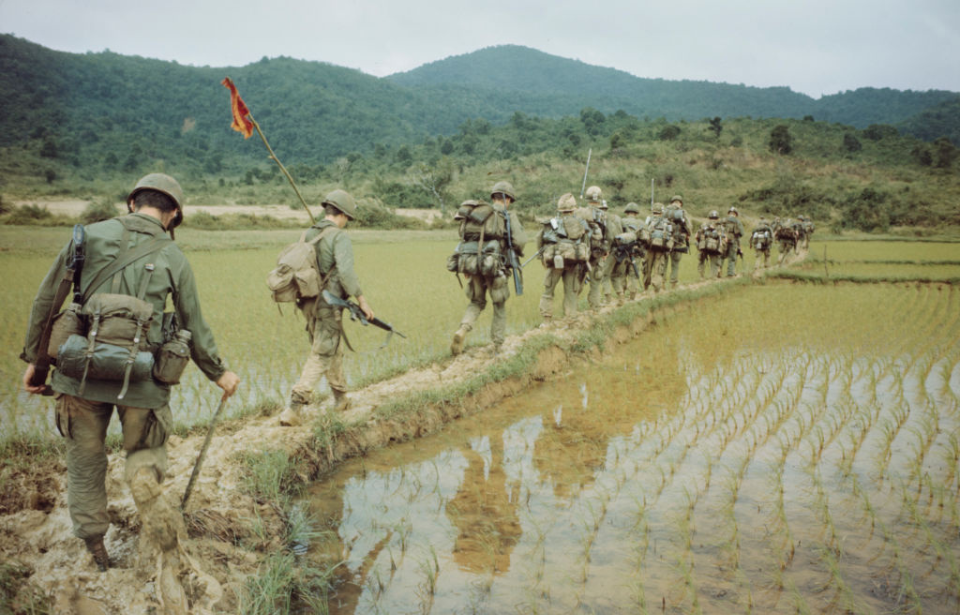
The Vietnam War was infamous for the guerrilla warfare the American forces were largely unprepared for. The Viet Cong were on home turf and used this to their advantage when it came to creating and laying booby traps. Not only were these cost effective, but the bamboo used to construct many of the traps didn’t register on the mine detectors used by the United States.
The goal of the traps was to maim, not kill, as this required the American soldiers to deal with their wounded comrades, slowing them down. This was made worse by the use of secondary traps, which targeted those attempting to help the injured. It’s alleged that 11 percent of deaths and 17 percent of US troops wounded between 1969-70 were the result of traps and mines. In 1965 alone, this number was at 70 percent.
These booby traps also had a devastating psychological effect on soldiers, greatly reducing morale. They were already fighting in difficult jungle terrain, and they also had to be on guard for well-disguised Viet Cong booby traps.
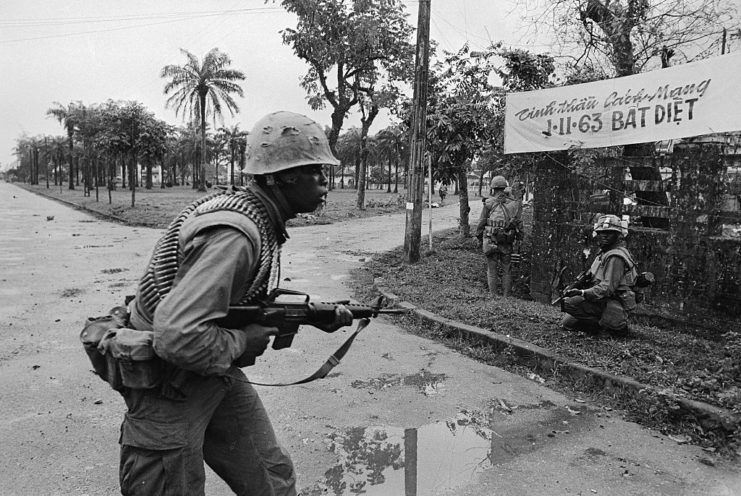
The bow trap was a simple, yet effective booby trap employed by the Viet Cong during the early days of the Vietnam War . A bow, pulled taut and prepped to launch, was attached to a tripwire. When an American soldier set it off, the bow released right where they were standing, resulting in a direct hit to the middle of the body.
Additionally, the some guerrillas set up this type of trap within a small pit. In these instances, the bow was angled upward, so the projectile would strike the enemy in the lower extremities.
Punji sticks
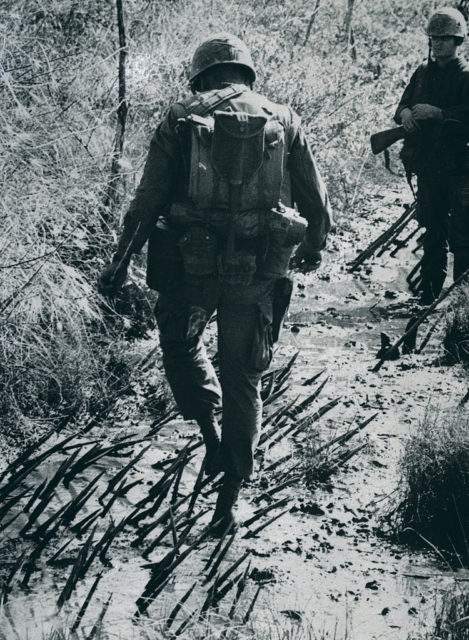
Punji sticks , also known as punji stakes, were a common booby trap deployed by the Viet Cong. The sharpened bamboo, wooden and sometimes metal stakes were often coated in feces or urine, with the goal of causing an infection in their victim. They could also be coated with poisonous substances from animals and plants.
Punji sticks were placed pointing upright at the bottom of a hole, before being covered with material that would camouflage them. When a US soldier broke through the flimsy cover over the hole, they would step on the spikes at the bottom and suffer injuries to their feet and legs.
This particular booby trap could be made worse in two different ways. The first was installing them at a downward angle, along the sides of the hole. When these extra stakes were added, it became difficult for the victim to get themselves out without causing further injury to themselves. This often resulted in the slowing down of their unit while efforts were made to free them.
A second way was by digging another hole next to the one equipped with the punji sticks, with the aim being to trap a second combatant with little additional effort. When a soldier came to rescue his injured comrade, he’d fall into the adjacent hole and become trapped.
Along with physically injuring American troops, punji sticks were also effective at hurting the overall morale of those serving within Vietnam’s dense jungles .
Bamboo whip
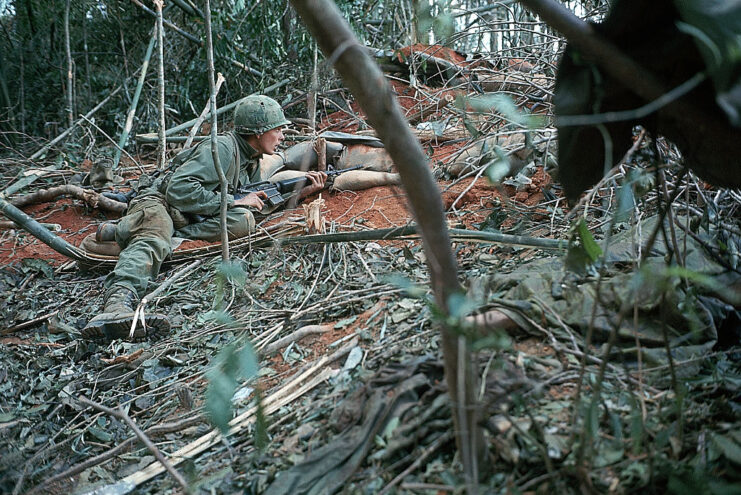
Bamboo whips were another brutal booby trap employed by the Viet Cong. A bamboo pole was attached to a tripwire and pulled back with a lot of tension. The pole had foot-long spikes attached to it, so when the tripwire was triggered, whoever tripped it would be impaled by the spikes as the pole whipped forward.
According to We Are The Mighty , the pole and its spikes could travel up to 100 MPH. As with punji sticks, the spikes could be covered in poisonous material to further impact the victim’s ability to heal.
Swinging mace
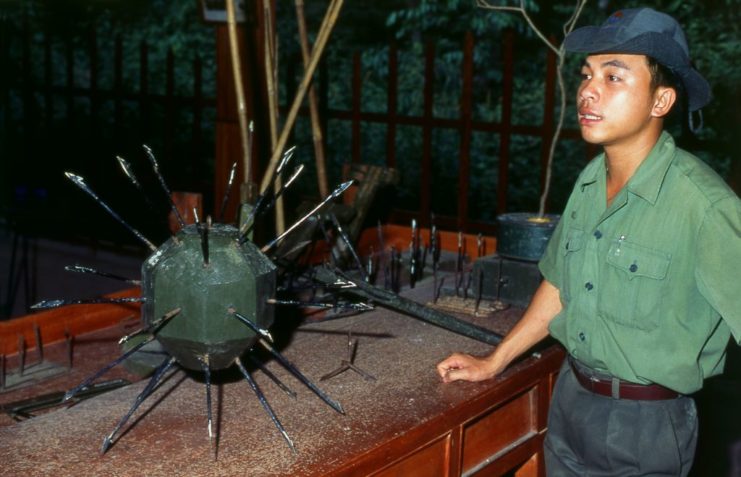
The swinging mace operated in a very similar way to the bamboo whip, but rather than be attached to a stick, the spikes were on a 24-inch clay, wooden or metal ball, which was triggered by another tripwire. Typically, the ball weighed upwards of 40 pounds.
This was one of the more brutal tactics utilized by the Viet Cong, as when the hidden ball was triggered, it would use the force of gravity to swing down from a tree and inflict terrible wounds to a soldier’s upper body – in particular, their head and upper torso.
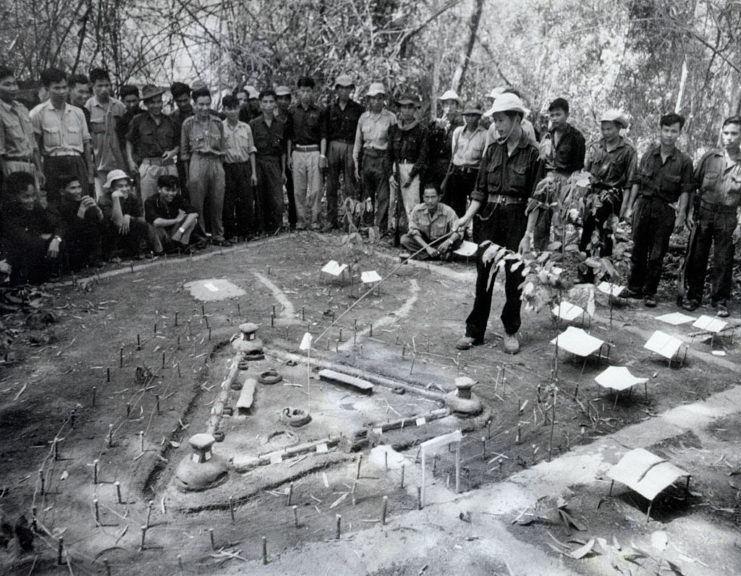
The tiger trap was another Viet Cong booby trap that, like the swinging mace, caused significant injury to a soldier’s upper body. The trap was sprung when the intended victim triggered a tripwire, causing a wooden plank imbued with metal spikes to fall on them.
This was made all the more brutal by the addition of weighted bricks or other objects on the board.
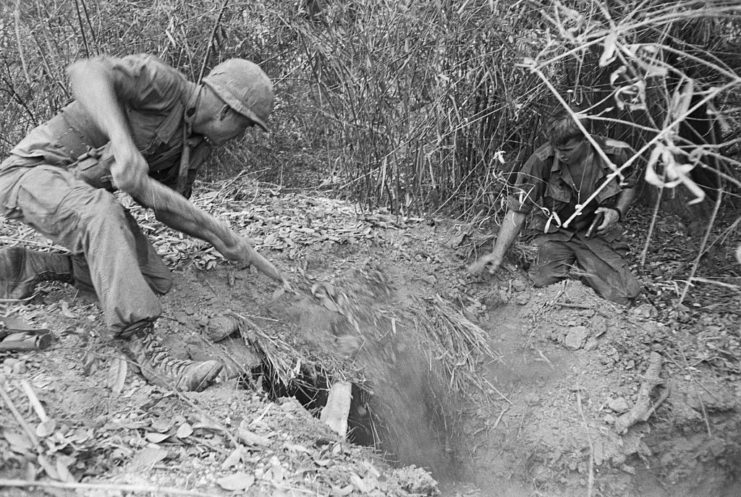
Snake pits were primarily used within the Viet Cong’s tunnel systems .
A poisonous snake would be attached to a piece of bamboo, and when released on the victim would place the reptile in the perfect location to attack. Snake pits were encountered by American “ tunnel rats , ” but the Viet Cong would put snakes in other locations, too, such as in their bags or in old weapons caches.
Bamboo pit vipers were a common snake used by the Viet Cong. Within a few minutes of being bitten, the flesh surrounding the bite turned necrotic, swollen and extremely painful. However, the Malayan krait was the most infamous, earning the nickname, the “two-step snake,” sometimes mischaracterized as the “three-step snake.” This is rooted in a myth that a soldier bitten by one was killed in the short time it took him to move two steps.

Cartridge trap
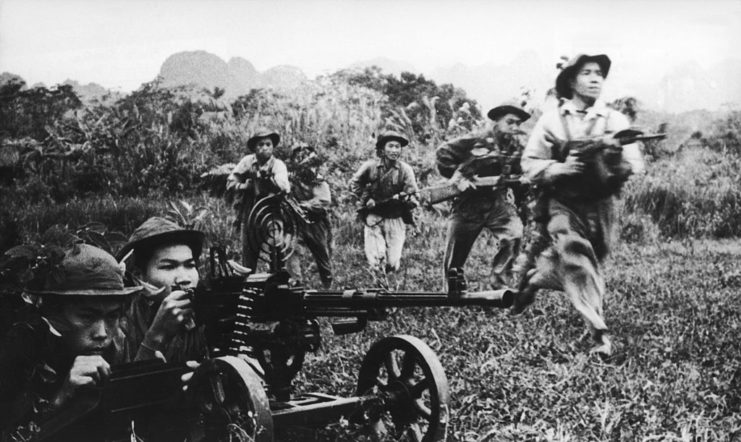
Cartridge traps operated in a similar way to punji sticks, in that they were placed within a hole in the ground. An ammunition round would be set within a tube made from bamboo, with a nail and wooden board placed underneath to act as a mock firing pin. Camouflage was then placed overtop to prevent enemy soldiers from detecting it in advance.
When they stepped on the booby trap, the soldier’s weight would activate the ammunition and fire it through their foot. As such, these were sometimes called “toe-poppers.” The extent of the injury was largely based on the size of the shell. Smaller ones often left men permanently disabled, while larger shells were fatal.
Grenade-in-a-can
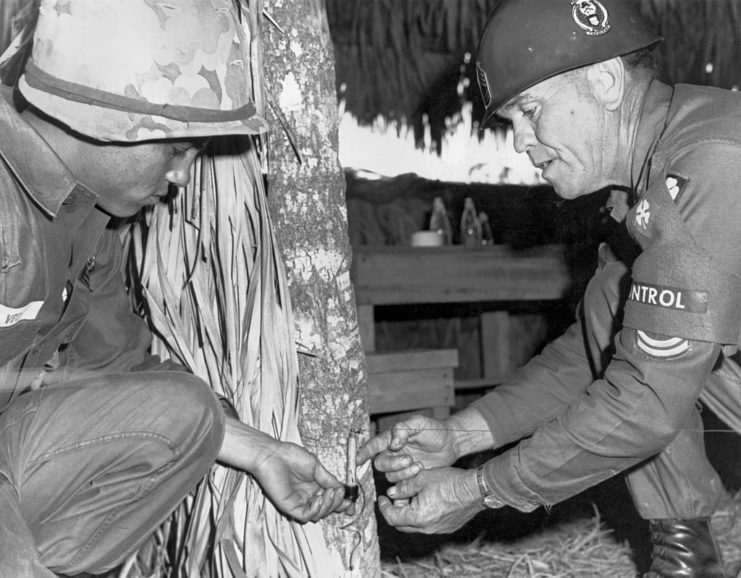
As the name indicates, the grenade-in-a-can was constructed by placing a grenade, with its safety pin removed, into a can, which held down the striker lever. A tripwire was then attached and, when tripped, would pull the explosive out of the can and cause it to detonate.
This type of trap could either be constructed with a single can and a stake, or with two. If two cans were used, they were mounted on trees on either side of a path, with the tripwire running between them. These booby traps were typically positioned in a stream and along the entrances to the Viet Cong’s tunnels.
Rigging war trophies
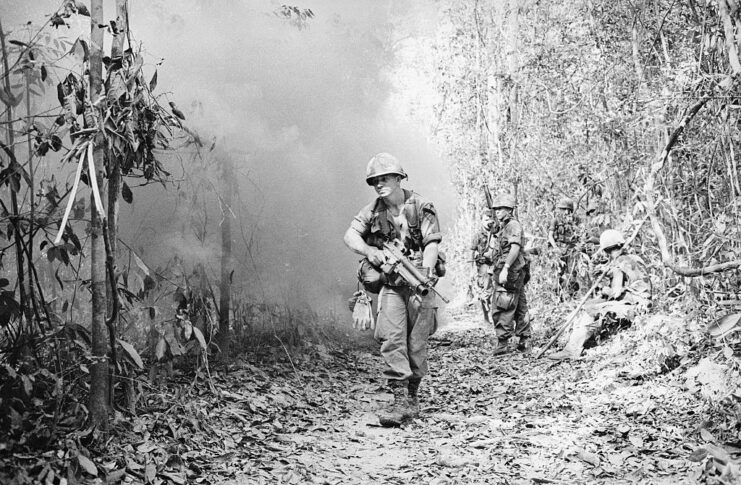
These booby traps were created based on the fact that American troops enjoyed capturing the flags of their enemies. When Viet Cong guerrillas were forced from their bases, they’d rig their flags with explosives, which detonated when the US soldiers took them down.
More from us: Cessna A-37 Dragonfly: The Forgotten Legend of Vietnam
The Viet Cong knew the Americans also enjoyed taking other items as war trophies. As such, they rigged them with similar explosives, so that, if the enemy combatants wanted to take anything from abandoned camps, the explosives would detonate, causing additional casualties.
- Скидки дня
- Справка и помощь
- Адрес доставки Идет загрузка... Ошибка: повторите попытку ОК
- Продажи
- Список отслеживания Развернуть список отслеживаемых товаров Идет загрузка... Войдите в систему , чтобы просмотреть свои сведения о пользователе
- Краткий обзор
- Недавно просмотренные
- Ставки/предложения
- Список отслеживания
- История покупок
- Купить опять
- Объявления о товарах
- Сохраненные запросы поиска
- Сохраненные продавцы
- Сообщения
- Уведомление
- Развернуть корзину Идет загрузка... Произошла ошибка. Чтобы узнать подробнее, посмотрите корзину.
Oops! Looks like we're having trouble connecting to our server.
Refresh your browser window to try again.
More Weapons Equipment

- Terms of Use |
- Privacy Policy |
- All Articles
- Editor’s Pick
- Survival Knowledge
- How To’s
- About Claude Davis
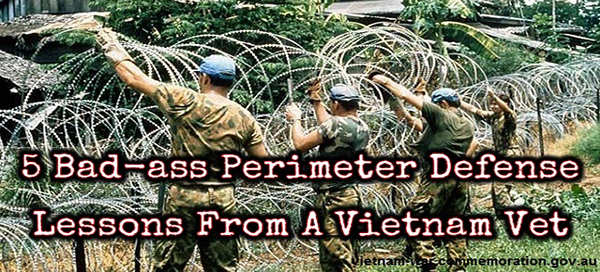
5 Bad-ass Perimeter Defense Lessons From A Vietnam Vet
by Mahatma Muhjesbude
Thank God you made it to your rural bug out location (BOL)! You almost didn’t get out in time before the Police State Metropolis you lived in had their National Guard soldiers shut down all further mass exodus from the quarantined city, with shoot to kill Iraqi War style road blocks on the last exits that weren’t already blocked by panicked mobs and burning piled up car crashes.
You get out of your bug out vehicle (BOV) and kneel down for a moment on the cool green forest ground in a soon to get very hot world, and give solemn thanks that you were granted the presence of mind and discipline to have your BOV ready to rock at a moment’s notice.
You will miss a few of the friends and neighbors you know you’ll never see again, and you’ll feel sorry for those who were trapped in their normalcy bias comfort zone and ignored the ominous but clear warnings. You will pray for them the first chance you get but right now you have another serious problem.
Beware of “Zombiez”!
You pulled ahead of the general Mad Max road rage on the Interstate and traffic finally thinned out considerably as you branched out to the county highways.
You started passing more and more stalled out of gas vehicles off the side of the road, now looted out, and deceased looking, with shot out windows and bullet holes in the doors. You noticed small groups of stragglers marching off the shoulder of the roads carrying their military grade weapons and back packs with grim desperate looks on their faces.
These were the ones who never cared about prepping. They had a different kind of survival plan. They were out ambushing, murdering, looting, and ravaging those who didn’t prepare their vehicles well for escape.
A couple of them raised their weapons to draw a bead on your vehicle as you floored it and screamed passed at over 90 miles an hour but they never had a chance for a good shot. You then had that sickening, kicked-in-the-gut feeling as you realized it was going to get really ugly, really fast.
You hoped your secluded location would minimize marauding this “zombie” contact and that you would have enough time to make last minute adjustments, and finishing touches to your dedicated compound perimeter security before you hunkered down and sweated out the inevitable anarchy looming on the distant horizon…
Reality Check!
Although different catastrophic/emergency and disaster events require different strategies and appropriate levels of preparation, they all share a single concept.
Security. Security, defense, and personal safety measures also span different levels of preparation effort and expense.
There is a lot of info out there now on urban home invasions and spontaneous concentrated urban rioting and looting , and how to protect and fortify your house from a break in.
This is a good idea in any case even before an apocalyptic scenario, and the harder and more time consuming you make it for a predator to attack and invade your city home or apartment the better the odds they’ll get caught at the door by police. Or give you time to escape at another egress or ‘gun-up’ in defensive counter attack mode behind some concealment/cover and take them out ambush style as they break in.
But in a doomsday scenario such as a major power grid collapse , sudden universal economic collapse, or super bad disease outbreak, there won’t BE any Police response, at least not for you. Fortifying your home’s doors and windows and stocking up on a few weeks’ worth of extra food and water won’t help you that much in the long run.
The first myth is that you can survive in place relatively easy if you read certain books. That might work through a hurricane, super blizzard, or local power outage that traps people for many days, but not in an all pervasive major social and economic, and resource breakdown that would last months and even years. This is an entirely different prep than surviving in place strategies. Do not make the mistake of not realizing the difference.
In the worst case SHTF event, you must be as isolated as you can from congested metropolitan areas if you want any chance for safety and survival. Period. Because sooner or later desperate and extremely psycho dangerous “zombies” will target your urban dwelling place and get through your home fortifications one way or another, and kill you, or burn you out.
Almost any house can be breached and broken into by determined attackers given enough time if there’s no worry about police showing up on the scene and the occupant/defender’s name is anything other than Rambo. And I don’t mean days, but more like only a few siege hours.
Even brick houses with bars or steel break in shades like you see on business storefronts in high risk areas. And if you somehow manage to kill them before they get in the first time, there will just be another group, even scarier, right after that in most large urban environments. That’s the reality.
Bug Out and Live!
The best way to initially survive a worst case scenario is to NOT to be around anything for very long that can kill you. Then remaining low profile if not completely secluded off the predator radar and out of targeting sight. Because why would anybody of sound mind, except in certain unfortunate personal circumstances, want to stay in a burning high rise hoping the sprinkler system will work when they could take the emergency exit out immediately?
So bugging out should be your primary plan. And the only place to go is out in the rural areas where contact with others is as limited as possible along with minimal profile footprint concealment. Once you’ve attained that, then the next part is making sure the “zombies” can’t just easily take it all away from you if they do stumble upon your hideout.
If you chose a decent BOL, some professionals with experience in this think it’s easier and more advantageous to your safety and security to make a virtually impenetrable perimeter barrier around your dwelling than it would be to seriously fortify a house/apartment in the city or town.
The factual truth is that these types of bad human relations as violent social conflicts have been going on since Biblical times and always contain certain elements. It always boils down to attackers and defenders. Fortified compounds, camps or castles, and superior firepower and tactics which change the advantage and even the whole game.
5 Lessons to Learn from Vietnam About Perimeter Defense
The art of this type of social warfare evolved to a stagnation point during the Middle Ages and then became obsolete during the evolution of the military industrial complex and modern world warfare that included airpower and massive tank warfare. It was not revisited and perfected until the mid-20 th century, in a small country police action in a faraway country called Viet Nam.
Ironically, as I draw from personal empirical knowledge and on the job experience and historic record on the comparisons and similarities, the best paradigm for survival perimeter combat preparedness comes from the Vietnam war, both when the French and the Americans were fighting it.
The lessons learned and strategies and tactics ultimately deployed became so refined and successful they remained in military application even to the modern Afghanistan war, and American mountain base camps and varies only due to advanced technology in weaponry and early anti-intrusion detection.
The Viet Nam conflict draws parallels similar to apocalyptic anarchy because political perspective notwithstanding, the typical American defenders hunkered down in camp compounds and defended against mainly ground forces who won‘t have air or naval power or sophisticated precision electronic detection or aiming technology.
The Viet Nam ground war was relatively primitive terms of force multipliers and its success, or lack of it, depended mostly upon small unit engagement with relatively basic weaponry.
Amazingly, today this type of fortification can be replicated on a smaller civilian but equally effective outcome on the private BOL compound today, and in a couple tactical applications, even better! Obviously the scale of enhanced force would be somehow different but the essential principles of applied dynamics and what works best are the same.
Here’s how to get started in the simplest, least expensive way.
1. Local Threat Evaluation
A combination of the likelihood of indigenous harmful contact and the random plain view discovery level of your BOL determine the odds of you getting approached by marauding “zombs”.
If they can’t see you from any road, there simply is not that much of a chance of many roaming predators getting into your area, because most of the area is inhabited by good people, more exposed than you but pretty self-reliant and well-armed, and they would pro-actively interfere with any groups of predators before they would ever get to your neck of the woods. So the likelihood of your BOL getting hit is very low.
Setting up a protective live defense perimeter barrier would virtually guarantee your long term survival of the rare one time attack if that happens, because almost any well prepared and armed prepper will have enough firepower, ammo and resources on hand to handle that. That is opposed to a long duration regular siege and total destruction type environment that would be common in anarchy ruled urban environments.
2. Barrier Protection
What does the Great Wall of China, the Berlin Wall, 13 th century castle walls and other heavy barriers have in common? Walls are the most difficult obstacles to penetrate or breach by humans without heavy destructive equipment, but they also are the most expensive.
If your intruder simply can’t move forward and gain access to you in your inner protective shelter without getting stopped one way or another by formidable outside barrier, then your perimeter security succeeded and you survived. That’s why it’s better to have an outside perimeter circle of defense rather than allow them to get too close to your main retreat.
Again, the Vietnam War proved beyond doubt that you don’t need a castle or great solid wall to get the job done. There are other, even better ways…
3. Perimeter Alarms
Aka anti-intrusion alerts and early warning devices. In Nam, we used anything and everything for perimeter alert from our empty beer and soda cans filled with pebbles, to the latest state of the art (at the time) forward terrain radar units and seismic ground sensors spread out even beyond the perimeter along with trip flares, and booby trapped grenades, and of course a healthy amount of pre-positioned Claymore mines if some of the attackers somehow get too far into the perimeter kill zone.
IF YOU KNOW WHAT YOU ARE DOING you can easily replicate most of that with modern electronic battery operated noise alerts either with PIR detection triggers or pull pin type trip wire activation along with careful use of pyrotechnics, or both. There are pros and cons with each, mostly depending upon if you have a lot of animals especially deer in your area.
Pyrotechnics are a very good tried and true method of alert and can be enhanced to perform double duty as a shock deterrent ONLY IF YOU KNOW WHAT YOU ARE DOING. The old saying is that there are only two types of pyromaniac powder monkeys: those who are already missing some fingers or eyeballs, and those that are getting ready to.
The other thing is the potential forest fire hazards if you live in a dry area especially if you are using the trip flares, instead of a flash bang alert.
There’s also the legality factor. Most states have strict laws on the amount of powder you can legally shoot off in a non-commercial/professional display personal firework. I believe the max is an ounce of retort/bang powder that you can shoot off or purchase without a commercial license. But check it for yourself before trying anything else!
Plus, if the DNR is snooping around your land and you made an oversized flash bang on a trip wire that damaged his eardrums that will become cause for arrest.
I know there is advice out there on how to booby-trap your doorways but I seriously don’t recommend doing that with anything that can kill or maim (stick with loud siren alerts or flashing lights only) because not only is it illegal virtually everywhere, but it will be only a matter of time before you yourself or someone you care about trips the booby-trap.
And I strongly recommend that you don’t get into that with common store bought fireworks, which could easily blind or burn an innocent victim or start your house on fire.
On a perimeter defense, the common larger over the counter fireworks like the bursting skyrockets and rapid fire mortar tube clusters pre-loaded shooting and bursting shells could be used just to wake up the group of invaders.
The burst charges are not black powder loaded, but contain the silver flash powder which provides a potentially dangerous hyperbaric close concussive effect even in only a cardboard tube with the legal maximum amount of powder.
Again, these are legal to own, but you can’t shoot them at people without getting into trouble. Just like guns.
But in an all-out lawless society where nothing will be adjudicated anymore in any system but God’s court after you’re dead, these are formidable perimeter counter attack devices because they also can be enhanced for maximum damage and launched on demand electronically from a secure rear position or even tripped by wire.
So it wouldn’t hurt to stock up on these because they’re legal and fun on the 4 th , and would definitely come in handy on a doomsday “holiday” as well, both as an alert and force deterrent out to a hundred meters or so. Like shooting mini-RPGs and a mini grenade launcher barrage on egress/entry routes backed up by hidden wireless security cameras, which now can reach distances out to five hundred meters or better.
But if you are just getting started, stick with the pull pin or PIR battery security sound alert/alarm devices.
You’ll immediately get why I caution you on this after your nephew or YOU forgot about it while out squirrel hunting, trip it yourself creating embarrassing Hershey Squirts in your under drawers, and your children or grandchildren will laugh at you mercilessly.
You absolutely need a lot of training and experience before you start playing with things that go bang. After you think you are safely proficient with the mind set of perimeter security devices, you can graduate yourself and augment to the trip wire re-loadable retort devices like the 12 ga. shotgun shell blaster.
These are on the internet for about $40. They can take a shotgun shell right out of the box but these don’t work well because it is designed to be used with a barrel.
By itself it just pop bursts not even loudly below the shot/slug, and doesn’t even become any shrapnel because the powder is a slow burning type and it just splits the sides. Waste of good ammo. But you can get louder blank shells and commercial screaming flares and loud bangers from specialty ammo vendors on line. Pricey but very effective alert and deterrent effect.
There are also other good and even cheaper percussive devices that use only .22 caliber blanks, shotgun primers, or the nail gun blanks which also work decently on a lesser scale.
4. Perimeter Intrusion Obstructions
Of course a high chain link or barbed wire fence always helps slow down people you don’t want coming in on your property, but these are easy to breach if you are a good climber or have a pair of wire cutters.
You can make it look like a FEMA prison camp and it will feel like one also, but it won’t do much good against anything but animals maybe, unless you electrify it, and I don’t mean horse/cattle fence. I mean you’ll need sizzling frying high amp prison fence to stop “zombs” using only a fence. Not to mention it will be pretty obvious to passers-by unless you camo paint it or something.
The next best thing is pyramids of concertina type barbed/razor wire rolls. Harder to breach without having heavier tarps or plywood which “zombs” certainly won’t have in their back packs. Easy to set up.
Or, you can do it cheaper and less labor intensive with something that worked so well in the Nam that we almost felt sorry for the enemy who tried to get through it because it always was like the proverbial shooting of fish in a barrel. We called it snag wire and/or tangle foot and as their moniker imply, once ensnared, they were almost impossible to get untangled from.
And all it amounted to was regular barbed wire rolled out on the ground in crisscross or lattice pattern on the ground at intersects less than an average human step, and propped up with stakes at various heights from ankle to knee level.
Enhanced by anything imaginable from punji spikes to tripwire grenades to napalm bombs along the way. Not to mention backed up by the secondary defensive firepower towers, and bunkers armed with heavy machine guns and LAW rockets and inner perimeter mortars.
Tangle foot would be comparatively easy and less expensive to set up in conjunction with the ’creative’ use of ‘passive’ natural terrain obstruction like tree limbs and boulders and heavy brush on your perimeter. You’d only need about an eight foot width across the part of the perimeter you were setting it up at.
Look closely at the seemingly natural and innocent looking forest pictures to the untrained eyes. In the pictures of downed trees and branches which were intentionally created as an egress obstruction.
You can’t walk or climb over that without falling, tripping, and twisting yourself to injury and entrapment while not getting far, as it stretches for several yards straight ahead and several yards to the flanks before you can make it through but hidden in the grass are also stretches of tangle foot.
So you would naturally walk around it until you found a pathway/clearing to continue on. This turns out to be a funnel zone which essentially lures the intruders into going where you WANT them to be herded. Which is replete with trip alerts, more serious booby traps, cameras, or whatever else you like when the SHTF and you no longer casually walk around in the area because you’re now in full defense mode.
And these funnel areas–which actually control the locations of entry to your compound–then become pre-set up dedicated fields of cross fire counter attack kill zones. Where you can lay a heavy ambush backed in and covered from the entry way or snipe them as they try to get all the way through and closer if they aren’t immediately deterred and retreat away.
If you look closely at the woods picture with the path on the right side, there is also a natural passive tree barrier on both sides going outside the picture for fifty or so meters either way.
It looks like storm/weather damage caused the blockage but it’s actually a clever expedient perimeter hack by bending down horizontally and staking down smaller trees cross wise which continue to grow and can’t be penetrated except by chopping through. The path is normally used for egress but can be tightly sewn up and protected fairly quickly.
5. Defensive Counter Attack Booby Traps and Other Devices
Don’t waste time getting into man-trapping devices like large snares, dead falls, punji pits, etc. These are so labor intensive, time consuming, and mostly don’t work, that it’s not cost effective in this day and age. And it will be a pain in the ass pulling out dead animals all the time.
Yes, they were used in guerilla warfare but only because the Cong were so piss poor and resource impoverished that they couldn’t do anything else. And good Point man could spot them a lot easier than trip wired grenades. When they got their little rice ball hands on better explosive ordnance, they quickly forgot about these primitive sticks and stones methods.
First and foremost and probably least expensive is a passive perimeter far enough away from your main compound/shelter that’s too far for an easy pick off gunshot or throwing of firebombs, usually over fifty meters and ideally about a hundred meters, with anti-intrusion alerts and deterrents.
Then augmented by tangle foot and strategic counter attack defense zones that can be upgraded later in a bad SHTF scenario with extra more effective counter attack equipment that you can make with legal supplies you already have in your stockpile.
Obviously we only touched the subject of base camp perimeter security, and what you still need to know if this article piqued your interest would fill volumes. But if you do have a serious interest in this I’ll answer any questions you have in the comments section and/or point you in the right direction for further edification on the subject.
This article first appeared on Survivopedia.com . If you liked it, please visit their website.
You may also like:
You Will Not Survive An EMP Strike Without This (Video)
Some Firearm Tips for New Preppers and/or Those Who are New to Firearms
What a Prepper Should Do Around The House
Building The Three Bucket Bio-Water-Filter
Comments 31
This is outstandingly presented and quite informative. The only thing I could productively suggest is applicable only in selective areas where blackberry bushes are prolific. It doesn’t take many years for a thick Blackberry hedge to be grown, especially when planted to pre-selected areas and supported by 5′ cattle or 3′ hog panels. As they are doubling as livestock barriers as well, they are also tax deductible. They well serve as entanglements as well. Integrating them with all the the other suggestions also doubles as a tasty food source.

Awesome suggestion. I’m always a fan of things that serve multiple purposes.
What do you think about giving your BOL or BIL the look that it has either been (a) already Looted; (b) Quarantined due to infectious disease; or (c) damaged by Fire in order to discourage trespassers and scavengers from entering? How would you do this and make this “look” convincing and effective?
Lou; Knowing I cannot bug out, I started buying plywood to put over my windows. It is all pre “torched”. All I have to do is screw the wood in place and finish torching the area around the wood.
I also have installed Lexan on my more vulnerable windows. It was a pricey project, but worth it. I have an older house with no storms so it essential I did something with the lower level windows.
I stored enough concertina wire to totally surround my house. I have stored 2 bags of trash (all washed) and baby diapers to throw around my yard to make it appear as if vandalism has already taken place. I hope I can enough fresh trash to throw up and down my street to make it look like the goons have already been through. This is just the tip of the iceberg of what I have done.
Don’t forget the over the door tricks. 🙂
There are many things you can do. Just use your imagination.
Along with blackberries, I found that in my area Mysore raspberries are a phenomenal perimeter defense option. I have it growing along my fence and it is roughly 7′ tall and about 5-6′ deep all along the fence. It grows like a weed (and in fact it is classified as a weed in some areas). Encounters with it are not pleasant, even if you’re just trying to pick that one perfect raspberry a few inches in. The secondary bonus is that I also have an incredibly abundant source of raspberries on hand nearly year-round.
Pyracantha or Firethorn bush also makes a good barrier bush.
I Remember the tanglefoot, also the blackberries and raspberries are a great idea ! How about caltrops? The Romans used a piece of iron about the size of a 16 P nail with a barb on the end. This was then put into a small block of wood , then driven into the ground. A very good article, thanks.
Caltrops are actually two pieces of metal bent to 90° and then fastened at together at the 90° elbow. That way there is always a pointed end up to impale the foot soldier or zombie. They can have other shapes, but that is the classic shape. It used to be the Division identifier for the 3rd Marine Division. Don’t know if it still is.
I showed my sons how to make caltrops out of fencing staples while they practice their welding technics, a half dozen of these sharp 1 inch long boot piercing staples welded together makes a stop you in your tracks weapon!
most never think to drive on the wrong side of the Xway when one side is jammed. it may get you out quite a ways if you proceed on the shoulder to avoid any traffic that should be lite. Knowing where and when to dodge incoming traffic will get you farther than the snail pace of the outbound side. This goes for surface streets as well but you will soon have many following you to jam this up as well. Grampa
When reading articles ALLEGED to be by Vietnam Vets, I have to wonder IF the author spent any time at all in combat.
EVERYTHING about the perimeter defense presented within this article could have been written by a teenager who reads comic books. Attributing the defensive tactics to VN appears to be an attempt at adding credibility to an extremely weak and meaningless description of perimeter protection. Contrary to what the author of this article portrays, Charlie(the Bad Guys in Vietnam) was very good at entering ANY type of perimeter; many times with impunity. Funneling traffic movement into fire zones does make sense IF the opposing force is totally ignorant or fire lanes. One day of learning by the Bad Guy will last a lifetime of perimeter assaults.
Do you want to be safe and protect both your family and assets during an extreme and potentially violent occurrence in your life? There is NO one size fits all. The best way to protect everything you hold dear is to anticipate what your adversary can do. If you live in a city; the Bad Guys can burn your building down, shoot/stab you, or herd you and your neighbors together and do whatever they please with you. If you live in a more rural area, the Bad Guys will have to spend an inordinate amount of time searching for you and yours. The Bad Guys will access the targets that are the most promising to them with the least amount of risk. Build your defense around making you and yours the least attractive targets for the Bad Guys.
GET A RADIO that monitors everything from local channels to CB to Police to HAM broadcasts. Gather your information by NOT directly exposing yourself to the Bad Guys. By LISTENING to the transmissions and learning as much about the capabilities of the Bad Guys, the direction the Bad Guys are travelling, and the number of Bad Guys will provide you and yours with the information necessary to make Swift and Informed decisions. PHONES will, most likely, be down, so the Bad Guys still will need to share information among themselves. You will have to listen around the clock. You will hear both Good Guys and Bad Guys. Learn from their conversations WHILE you keep your mouth shut. If you can hear them, they can hear you.
Excellent suggestions. Know your enemy and his capabilities… Are you facing a band of lightly armed marauders or a well equipped army? Everything changes when you are facing a disciplined trained force. In Viet Nam “Victor Charles” was extremely adept at breaching barriers, walls, water boundries ect…So called “sappers” could weave their way through concertina wire and other obstacles quickly and with little or no injuries in the process. I remember watching former VC ( HAHA I often laughed thinking of the phrase “former VC”) slither through thick concertina wire. Very sobering. And the importance of “Comms”? Crucial! The article” 5 Bad-Ass Perimeter Defense Lessons” has some merits yet I agree with you that there is no one size fits all remedy. Knowing what you are facing and good communications are the key.
Rocky: When the stepson was 10, I took him to the armory and introduced him to the soldiers. They loved him because he was a war movie fanatic and very up to date on everything. He spent so much time there, they ‘hired’ him to sweep out the place, taught him how to operate a tank (I had him driving stick before he was 11), and all about guns. To pay him, he was given junk, shell casings and so on. He decorated the place with old concertina wire and the Dominicans and Mexican in the ‘hood were in awe and loved it. He later went Army and did real well. He should have stayed in, but his mother kept calling and harassing him. His uncle wanted to get him in AI and said he was a natural. niio
You’re right about that. Someone forgot about fire minutes, you would fire for a minute on hour around the parameter to discourage intruders VC, NVA. Just hope they don’t have any heavy machinery to bulldoze through it. What is being talked about is choke points, but under the circumstances it may be difficult to use them properly. Best to get an alarm system so you get alerted when needed along with the choke points. An inexpensive way and DIY is to make pepper spray out of super hot chilies, Carolina reapers i think they are called, use as a powder or with oil. The powder could kill if you inhale too much. Not glamours but it works if done right. Make this outside and wear a mask and gloves.
What kind of radio do you recommend for monitoring the bad guys that does all this but yet they cannot hear you?
Such a radio does not exist without military encryption
My wife and I recently moved to a rural location well over a hundred miles from any big city and about ten miles from the nearest small town. In addition, we are over thirty miles from any interstate or major highways. All of this was intentional as we are retired and had the freedom to locate where we pleased. I still spend considerable time thinking and planning perimeter defenses just in case. I am really interested in the tangle foot traps. I have ideal locations for laying them out in a strip of pine forest on two sides of our house. The other two sides face open pasture. I already have the makings for several trip wire alarms. Interesting article.
Good advice, and I hope we see better movies teaching this. Matt Damon’s dippy pandemic flick was not made for thinkers. niio
Long term bug out or bug in I think the double duty thorny bushes are a great idea, but not machete or fire proof. Having that stock of plain barbed wire, as the man says, makes excellent sense for perimeter cause it will also tangle and ruin any mechanized or mounted approach (4 wheelers, horses, etc) if it punctures or wraps. It’s true that one can cut their way through the wire with a bolt cutter, but far more folks will have machetes out there in the bug-out-bush.
When you install the tangle foot, you could likewise plant the bramble bushes within in it, thereby making it even more difficult to penetrate or cut through using a machete or fire the tangle foot will still be there.
Sarge: Problem (for here). In Arizona an old desert rat told me (a lot of decades ago), if it ain’t got thorns, horns, or fangs, it’s poison. Most people already know that and will avoid ‘desert landscaped’ homes. Pretty much everything around the house is loaded with thorns, including fruit trees (citrus, hackberries, apple cactus). All that cover is attractive to rattlers, but they leave when the sun comes up. Chain link fence around the backyard is getting a few lines of barbed wire on the inside. And, if we can manage it, grapevines to cover the fence, which attract scorpions, but they hide, as well when the sun is up. As long as you know how to use nature, it’s a major plus and not exactly harmful. niio
Yo, yes. One thing that used to be common was a heavy planter inside gates. People forcing themselves into a yard or house would fall over them. ankle height white wires (same color as the doors) it stretched at night before bed or when we go out. They fit against the door and can’t be seen. Plenty more, as well. niio
I’ve been prepping for several years now. My husband has finally joined me in preparing for when the SHTF. We moved from a indefensible place in a town in the NE to a tiny town in the Colorado mountains far away from the bigger cities. I’ve been reading your suggestions for awhile now, but feel that we are in a difficult spot. We can’t afford to get a BOL. We’re retired and renting, so we are limited regarding defensive perimeter defenses and home fortifications. Any suggestions might make me feel more confident.I hope you have some suggestions for us. Also, what is “niio”??? : )
Keek: We’re ani Susos Kanonona, people of the Corn Moon, Susquehannock. My grandmother would applaud you because as Pappy noted, women are the wise ones. niio is Cherokee Iroquois for Walk in God’s beauty. And, Nana would likely threaten your hubby with her steel reinforced hairbrush with automatic tongue lashing. You understand your situation far better than we do. LCC has forgot more than most of know. Others here, ClergyLady and Miz Kitty are a definite plus. Fr. Bob needs to interact much more, as well. These people are our rock in troubled waters. But, having lived in the NE but in rural areas, first, socialize with the new neighbors. If you have kids, that’s fantastic because kids are more accepting of kids, more open. Kids are chatty and you’ll learn a lot from them, as will your neighbors from your kids. In conservative ‘hoods, if the husband isn’t home, neither are you. If a woman comes to the door, OK, you can talk, but if a man, no! No conservative man will bang on the door if hubby’s vehicle is gone. The old saying goes, a woman has her reputation and her children. If she gets a bad rep, her children will suffer for it long after she’s dead. Be helpful, always, but a handout is hated. If needed, accept with grace, but also a little–a touch of–anger to show you resent being in need shows you’re not a moocher. If it’s a welcoming gift, ACCEPT it with thanks and a smile. such things are like gold. Always return favors ASAP. Always show respect, especially for elderly. Even if you disagree, respect them because 1) they earned it by surviving and 2) they’re local and have family who will appreciate it–and you’ll get apologies from them “Pappy isn’t well and gets a little crotchety, please don’t mind.” Remember high school? Become local but never suck up. In many ways, you’ll always be that person from. Accept that and when in Rome, do as the Romans. Be part of it, but always remain somewhat independent. This is a partial, and you’ll run into situations where you’ll be lost but will muddle thru. Be like Jesus, who was always kind till the time came for something else. niio
Red I like this, except for the part “Accept that and when in Rome, do as the Romans”. This is not good if you are in a shft situation. If those around you are looting and raiding then you have lost your way. But the rest of this goes along with being honorable. Men and women have only one thing that is theirs forever. That one thing comes from Honor. This thing is what a real man or a real woman is made of. If it can be said when you are gone that you were honorable then there is nothing else needed. Honorable means that you are honest, have respect for others, and do what is needed even if it means you will die doing it.
Dreaded: Honor is an awesome responsibility. When it comes to keeping the kids safe, it blows out the window. If raiders want to attack us here, then they get exactly what anyone else in town would give them. Raiders, rioter, and looters are not part of the local scene. My neighbors are. It’s unlikely anyone here is going to run to Tucson to raid but very likely outsiders from Tucson will. niio
I am in the same situation as you are and there is a lot that can be done without money. Most of it will have to wait until the shft actually happens. The reason it will have to wait is you can not set booby traps that will maim or kill, you can not setup bug out site, and you can not build defense system around where you live due to regulations. All of this takes money. I live in a area that is rural but near town and within 15 miles of a good sized city. My neighbors are all good people and most of them will band together and fight off intruders. I have guns, ammo and a 2 month food supply put back. Anything I could do would make it apparent that I am prepping which would make me a prime target. So I have to set back and do what I can like buying food and ammo when I have extra funds. Best thing we that have no funds can do is to prepare ourselves physiologically. When the time come you will have to kill other people. This will change you. You will have to refuse giving food to beggars. If you are a Christian then you have your faith to deal with too. I am a Christian but I served in the military and know that you can kill to protect yourself and loved ones. So there is not much you can do without drawing attention to yourself and making your self a target for not only when a shtf but in todays society there is people that will kill you for a dollar.
A good defense is to make sure that you look like you have no supplies.Use trip wire to make intruders trip.Make sure to camouflage your trip wire by using trip wire that blends in to the environment.
AP: my stepson and his sisters have this lust, no other word fits, for razor wire. I like heavy black fishing line and bells (it’s a Christmas-thing 🙂 Cactus, ocotillo, plenty of wolfberries, and hackberries. If it has thorns, its Arizona adapted, and is eatable, I’m all for it. All that brush makes Mouser the rattler feel right at home. She goes ‘home’ to the cactus thickets and her hiding place during the day. niio
A very good article and great comments about a worst case SHTF…
BUT really only if you have a small country town to protect and have significant military tactics, manpower, and assets to deploy.
However, if you are a small group and want to survive beyond two years, most of this info is going to get you killed.
The waves of millions of “zombies” will overrun most BOL defenses in the first year.
And the smart and strong ones who make it to the 2nd year will be faced with the worst wave of all…
The ex-military trained “zombie” squads who are experts, or have been trained by the experts…their scouts are looking for YOU, and they will find you. They will respect the fact you are not a push over and you will never know they are there until it is too late…they will use guerilla tactics to suddenly capture or destroy your BOL.
Bringing any attention to your location is a death sentence.
You have to disappear for 2-3 years…the really smart ones that have a large bank account and five years to secretly and properly prep their underground BOL…they will probably be the future of the human race.
Think like you are on a mission to mars…and prep for just that with redundancies for everything.
Sorry…Everybody above ground is exposed to numerous scenarios that will kill most of them.
May God help us all if a worst case SHTF scenario suddenly begins…
J: Most would be lucky to survive the first few weeks. Sheep will wait, hoping for help because from an early age that’s how they were brainwashed. Those who survive being abandoned by big brother will be bitter and damage anyone they come across. Hitler stated, “I want to raise a generation of young people that will be void of a conscious, relentless, imperious, and cruel.” The dnc managed to do that. niio
Leave a Reply Cancel reply
Your email address will not be published. Required fields are marked *
Save my name, email, and website in this browser for the next time I comment.
Privacy Policy Agreement * I agree to the Terms & Conditions Terms & Conditions .
This site uses Akismet to reduce spam. Learn how your comment data is processed .
FOLLOW US ON:
Prepper recommends.
IF YOU HAVE THIS ON YOUR PROPERTY, HIDE IT IMMEDIATELY
THE ONLY HERBAL REMEDIES YOU NEED TO ADD TO YOUR STOCKPILE
WHY YOU SHOULD BURY A TRASH CAN IN YOUR BACKYARD
HOW TO STOCKPILE ANTIBIOTICS WITHOUT A PRESCRIPTION
YOU WILL NOT SURVIVE AN EMP STRIKE WITHOUT THIS
IF YOU SEE THIS PLANT IN YOUR BACKYARD BURN IT IMMEDIATELY

YOU CAN ALSO FIND US ON:

Copyright © 2014-2024 Ask a Prepper
- Terms of Use
- Privacy Policy
- Join Our Email List

- $0.00 0 items

North Vietnamese Army Viet Cong Trip Wire Rolls
$ 199.99 $ 139.30
Login or Create a free account to save this item to your Wishlist!
Have a question about this item? Ask us anything
- Name of item inquiring about
- Comments This field is for validation purposes and should be left unchanged.
Why buy from Enemy Militaria? • Lifetime authenticity guarantee. • 30-day return policy. • We've been collecting and selling militaria since the mid 1970s. • Our online store has been in business since 2017. • We accept credit cards & mailed payments. • We ship worldwide - shipping rate will show in your cart before you pay. • Enhanced staffing for fast shipping. • We are veteran owned.
Want first dibs when we add new items? Join Our Email List
100% Authenticity Guaranteed
We pride ourselves on the authenticity and quality of our items. We offer a 30-day money-back guarantee on all items — period.
Shipping & Return Policy
Join over 5,000 militaria collectors around the world! Get first dibs when we have sales and add new collections for sale!

Sign Up Today
Start your 14 day free trial today

The History Hit Miscellany of Facts, Figures and Fascinating Finds
- 20th Century
8 of the Most Dangerous Viet Cong Booby Traps

29 Oct 2020
The Vietnam War (1955-1975) effectively became a proxy Cold War battle over communism, with North Vietnam supported by the Soviet Union, China and other communist allies, and the South supported by America and anti-communist allies.
The Viet Cong were the guerrilla force that, with the support of the North Vietnamese Army, fought against South Vietnam and its allies. Despite the superior firepower of the American military, the determination of the Viet Cong was exceptional, and they were experts in utilising their surroundings to create booby traps to hamper America’s ability to pursue them in a retreat .
Booby traps were cheap and relatively simple to make, and the Viet Cong used them to devastating effect. Unlike mines, many of the booby traps laid were made from bamboo which could be hidden from mine detectors, and often worked on their own, meaning traps could be set ahead of time without the need for monitoring.
Many were designed to maim instead of kill – not only did this mean other soldiers were required to remove their wounded colleagues which hampered operations, but it also meant the traps were a psychological weapon as word about them spread. It’s estimated that approximately 11% of deaths and 15% of wounds to American soldiers were caused by booby traps and mines in the Vietnam War.
Here are eight of the most dangerous traps:
1. Punji sticks
Punji sticks were the most infamous of the booby traps used, said to account for 2% of wounds to American soldiers. They were mostly made out of bamboo (though sometimes metal) in varying lengths and width, and had a simple sharpened spike on one end to impale its victim. Sometimes the sticks were smeared with urine, feces or plant poison to also cause infection.
The sticks were often jammed into camouflaged pits dug in areas likely to be passed through by American troops, which soldiers would then fall in to and become impaled. The point of penetration was usually in the lower leg area, with the sticks not necessarily meant to kill but rather designed to would or slow down a unit whilst victims were evacuated.
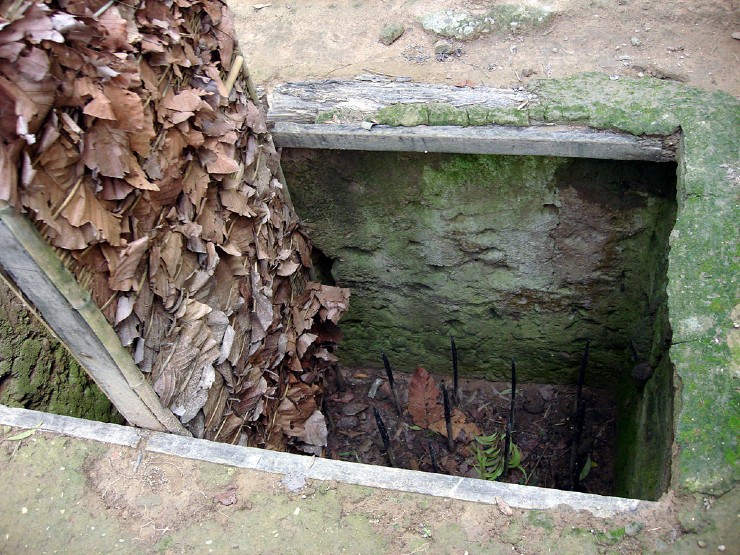
Punji stick booby trap with bamboo spikes – Cu Chi tunnels. (Image Credit: Jorge Láscar / CC).
Sometimes the sticks pointed downwards at an angle, with soldiers stepping into a pit unable to remove their leg without causing further damage. Occasionally the Viet Cong would dig pits beside each other, so when a soldier fell in and needed help, his colleague would then get trapped in the pit next door.
Punji sticks were also used in conjunction with barbed wire, in tunnels and sometimes deployed in preparation for an ambush in areas where soldiers might be expected to take cover, thus impaling themselves in the process.
2. Grenade Traps
These were usually placed along tunnel bases or in a stream. One side of a string was attached to a stake rising up from the floor, with the other side attached to the safety pin in the grenade. When a soldier tripped the wire, the grenade would detonate.
Alternatively, grenades were used inside cans – these were fastened low to the ground or tied to trees either side of a path and connected by a wire. The grenade’s pins had already been pulled before being inserted into a can, with the safety lever held down. When the tripwire was triggered by a soldier’s foot, the grenades were pulled from the cans, releasing the safety levers and igniting the grenade.
3. Cartridge Traps
Sometimes known as ‘Toe-poppers’ these were small arms cartridges such as bullets that were placed within a bamboo tube and over a nail, and then camouflaged in the ground with the tip protruding. When stepped on, the pressure placed on the bullet would force it down onto the nail, igniting the primer and exploding.
This created an opportunity for the Viet Cong to ambush whilst the wounded solider was treated. The traps usually wounded, but could be fatal depending on the shell ’s size.
4. Snake Pits
Snakes were commonly used in traps inside tunnels. Tripwires would trigger the release of snakes hidden inside bamboo sticks. Often poisonous snakes were used, and were known as ‘three-step snakes’ as that’s how far a soldier could make it after being bitten by one, due to the snakes’ venom. American “tunnel rats” had to be specially trained to navigate and disarm these traps.
Snakes were also hidden by the Viet Cong in soldier’s packs, and sometimes tied into the branches of trees by their tails at face height.
5. The Mace
Possibly one of the worst booby traps US soldiers faced was the mace. Based on a tripwire, once the wire was triggered, a large metal or wooden ball with spikes would swing down from a tree.
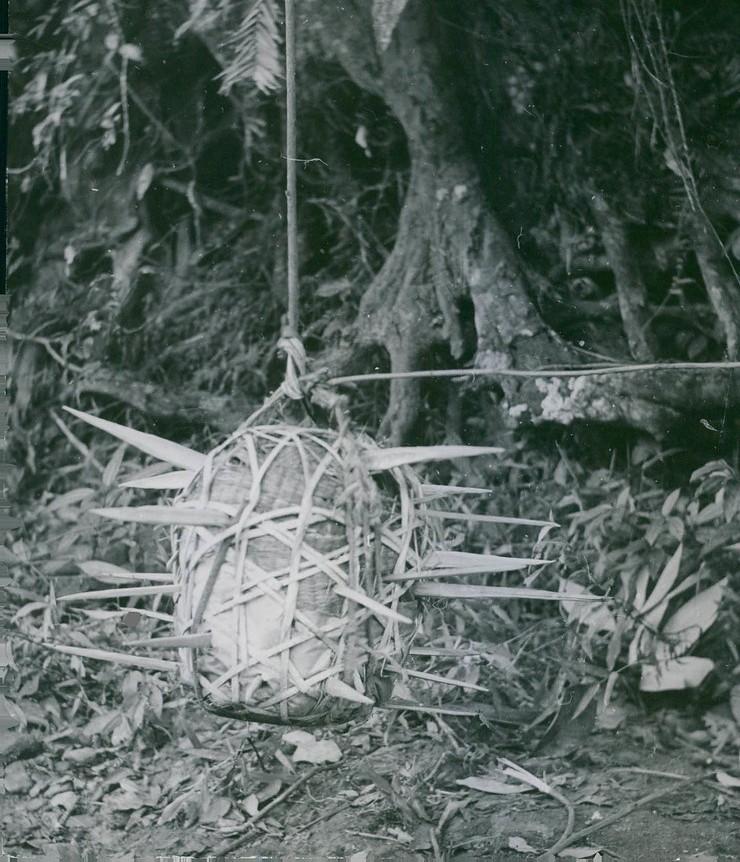
Viet Cong Flying Mace Booby Trap (Image Credit: manhhai, Flickr / CC).
6. Tiger Traps
Similar to the mace, the tiger trap consisted of a weighted, spike-studded board. A tripwire would undo the catch on a rope, releasing a plank weighted with barbed metal spikes.
7. Pressure Release Traps
The Viet Cong quickly learned to booby trap not only items that were of military importance but also items such as flags and other war trophies. The NVA and Viet Cong loved to fly flags and knew US troops liked to capture them – when forced to leave a location, they often rigged the flags with an explosive, so when US troops started to take down the flag, the booby trap would go off.
The Viet Cong also frequently used secondary booby traps, so as soldiers rushed in to help injured colleagues, a delayed secondary charge would go off.
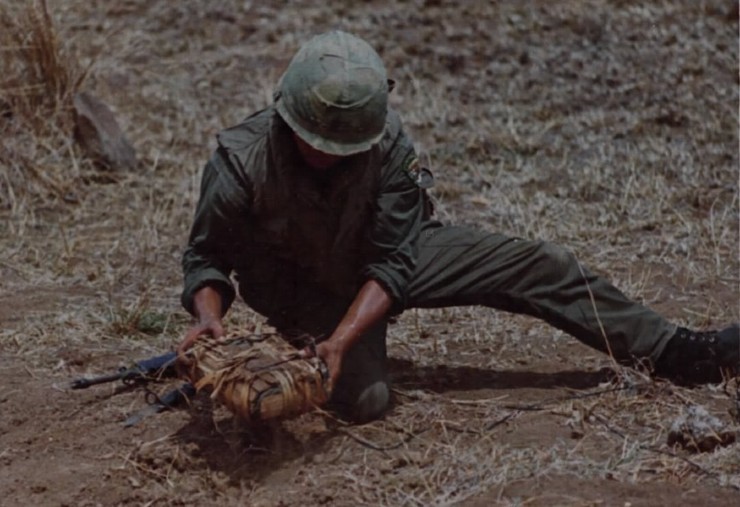
A Korean soldier of the 26th Regiment, ROK Tiger Division, lifts a Viet Cong booby-trap from the ground during a demonstration near HQ, Song Cau. (Image Credit: NARA / Public Domain).
8. Bamboo Whip
Spikes were placed over a long bamboo pole, which was pulled back into an arc using a catch attached to a tripwire. When the wire was tripped, the bamboo pole whipped back into the straight position, impaling the soldier who had triggered the tripwire.

You May Also Like

Mac and Cheese in 1736? The Stories of Kensington Palace’s Servants

The Peasants’ Revolt: Rise of the Rebels

10 Myths About Winston Churchill

Medusa: What Was a Gorgon?

10 Facts About the Battle of Shrewsbury

5 of Our Top Podcasts About the Norman Conquest of 1066

How Did 3 People Seemingly Escape From Alcatraz?

5 of Our Top Documentaries About the Norman Conquest of 1066

1848: The Year of Revolutions

What Prompted the Boston Tea Party?

15 Quotes by Nelson Mandela

The History of Advent
Tripwire!: A Worthy Vietnam Veterans Documentary

The web site, Soldiers & Civilians Project , has just gone live. It is the home of an…
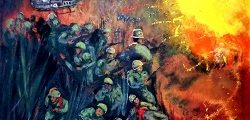
Isabel Duran's two brothers, David and Ignacio Duran, served in the Vietnam War with distinction. David Duran received…
A. J. "Jack" Langguth, who covered the Vietnam War for The New York Times and who went…
Vietnam veteran Ted Engelmann is an accomplished photographer, teacher, and writer who divides his time between Denver and…
Stay informed about the latest veteran news
- Archives (15)
- Art Exhibits (43)
- Artistic Queries (111)
- Arts on the Web (68)
- Book News (145)
- Book Talk (19)
- Comic Books (9)
- Conferences (16)
- Documentaries (120)
- Essays (31)
- Feature Films (81)
- History (114)
- Honors and Prizes (16)
- In the Classroom (24)
- Journalism (35)
- Journals (10)
- Magazines (21)
- Memorials (32)
- Museums (31)
- Musicals (10)
- Obituaries (67)
- On Line (23)
- On Stage (18)
- Photography (58)
- Poetry (54)
- Sculpture (8)
- TV Series (11)
- Benefits Updates (27)
- Anthology (3)
- Antiwar Movement (9)
- Audiobook (1)
- Australian Vietnam veterans (1)
- Biography (27)
- Childrens (3)
- Compliation (12)
- Detective Novel (7)
- Diplomatic History (3)
- Electronic Book (94)
- Fantasy (2)
- Fiction (225)
- Fiction War short stories (1)
- Graphic Novel (1)
- Guidebook (5)
- Iraq War (1)
- Memoir (55)
- Military History (21)
- Mystery (9)
- Nonfiction (378)
- Novella (4)
- Oral History (15)
- Paperback (429)
- Papterback (1)
- Reference (11)
- Science Fiction (3)
- Self Help (9)
- Short Stories (19)
- The Wall (1)
- Thriller (25)
- Vietnam Veterans Memorial (1)
- Vietnam War (35)
- Vietnam War biography (2)
- Vietnam War fiction (4)
- Vietnam War History (35)
- Vietnam War memoir (7)
- Vietnam War novel (7)
- Vietnam War poetry (1)
- Vietnam War post-traumatic stress disorder (1)
- Vietnam War themed novel (10)
- World War II novel (1)
- Credentials Committee (2)
- Econominc Opportunities (5)
- Elections Committee (1)
- Finance Committee (3)
- Leadership Conference & Planning Committee (1)
- In Service Newsletter (13)
- Inside VVA Chapters (661)
- Membership Affairs (9)
- Press Releases (212)
- Faces of Agent Orange (32)
- Education (24)
- Government Affairs (42)
- Homeless Veterans (40)
- Minority Affairs (30)
- POW/MIA (80)
- PTSD & Substance Abuse (54)
- Veterans Against Drugs (11)
- Veterans Health Care (31)
- Veterans Incarcerated and in the Justice System (44)
- Public Affairs (13)
- The VVA Veteran (71)
- VA Voluntary Service (11)
- Vietnam veterans (32)
- VVA Testimony (141)
- Web Weekly (362)
Claims Assistance
Publications, our members, financial readiness, legislative action, offers for members.

IMAGES
VIDEO
COMMENTS
Fith Ops Original USA-Made Camp Safe 12 Gauge Perimeter Trip Alarm Device, Pest Deterrent. $3995. Some of these items ship sooner than the others. 0:25. REMFLY Perimeter Trip Alarm, Camping Trip Wire Alarm Device, Early Warning Security System for Camping and Property Safety, Use 209 Primers 97. $2199. 0:34.
8. Tiger Traps. A tiger trap was similar to the mace, in that a tripwire would undo the catch on a rope. Only instead of a swinging ball, the death from above took the form of a man-sized plank weighted with bricks and full of barbed metal spikes quickly falling to earth on someone's forehead. During the Vietnam War, the Viet Cong troops couldn ...
The USGI Vietnam Era Trip Wire is a versatile, historical military tool. Made in the USA, this unused, full spool wire is durable and practical. Initially used in the military for defense and traps, its modern applications are vast. Suitable for perimeter alarms, DIY snares, and securing gear, it adapts to various needs, embodying ...
Call Us: 1-800-653-8528 or Contact Us. Product Description. Reviews. Never used, approximately 5,000 ft. per roll on wood spool, metal wire, silver in color (may have slight rust due to age)
USGI Vietnam Trip Wire; USGI Vietnam Trip Wire. Add Your Review . $11.99. In stock. SKU. MA305. Qty. Add to Cart. Add to Wish List. Share. Skip to the end of the images gallery . Skip to the beginning of the images gallery . Details . USGI Tripwire 160 ft on each wooden spool. 2 each 40 ft yellow lengths and 2 each 40 ft OD lengths on each ...
Description. NOS US Military Vietnam Era Trip Wire. The wooden spools show signs aging such as small chips, cracks, or discoloration from shelf storage. Wooden spool has 4 rolls of wire, 2 olive drab 2 yellow. Spool measures approx 1 3/8 in. diameter by 2 ¾ in. tall Each of the four sections of the spool has 160 ft of wire. Price is for 1 spool.
New USGI Vietnam Trip Wire; New USGI Vietnam Trip Wire. Add Your Review . $11.95. In stock. SKU. MA305. Qty. Add to Cart. Add to Wish List. Share. Skip to the end of the images gallery . Skip to the beginning of the images gallery . Details . USGI Tripwire. 160 ft on each wooden spool. 2 each 40 ft yellow lengths and 2 each 40 ft OD lengths on ...
U.S. Government issued Trip / Snare Wire 160' Vietnam Era Emergency Survival. Military Depot. $12.50. (No reviews yet) Write a Review. Current Stock: Quantity: Add to Wish List. USGI Trip / Snare Wire 160' Vietnam Era Emergency Survival.
Bill Maier, 35, says he was also a trip-wire veteran. The former marine, who saw heavy combat in Vietnam, said he had sought refuge in the woods from his recurring nightmares. 'Afraid of ...
Find helpful customer reviews and review ratings for USGI Trip / Snare Wire 160' Vietnam Era Emergency Survival at Amazon.com. Read honest and unbiased product reviews from our users.
The bow trap was a simple, yet effective booby trap employed by the Viet Cong during the early days of the Vietnam War. A bow, pulled taut and prepped to launch, was attached to a tripwire. When an American soldier set it off, the bow released right where they were standing, resulting in a direct hit to the middle of the body.
Get the best available price on USGI Trip / Snare Wire 160' Vietnam Era Emergency Survival at Capital One Shopping. Products. Products. Brands. All Brands. Apparel. Automotive & Vehicles. Beauty & Health. Books, Movies & Music. Business Supplies & Services. Department Stores. Electronics Hardware & Audio. Energy and Utilities.
4 spools USGI Military Trip Wire Yellow OD Green ~150ft. Vietnam - New Old stock. This one's trending. 953 have already sold. Breathe easy. Returns accepted. US $8.40Standard Shipping. See details. 30 days returns. Buyer pays for return shipping.
These rolls of trip wire were placed around camps and bases and were set up to trigger flares, bobby traps and Claymore mines. More Weapons Equipment. Night Vision Sight PVS-2. XM3 Bipod. XM3 Bipod Cover. XM3 Bipod Cover 2nd pattern. XM3 Bipod Cover 3rd pattern. XM3 Bipod Cover 4th pattern.
Vietnam Era Trip wire. We have several of these available and all are in similar condition with similar markings to the one pictured. Additional information. Weight: 4 oz: Dimensions: 3 × 2 × 1 in: Model: Trip Wire. Manufacturer: US. Related products. Cammenga Model 3H Tritium Lensatic US Military Compass $ 65.00.
5 Lessons to Learn from Vietnam About Perimeter Defense. ... most of that with modern electronic battery operated noise alerts either with PIR detection triggers or pull pin type trip wire activation along with careful use of pyrotechnics, or both. There are pros and cons with each, mostly depending upon if you have a lot of animals especially ...
This Vietnam-era tripwire is as useful as ever with over 160′ of 24-gauge strength ready to set a perimeter anywhere. $24* at Amazon *Price at time of publishing; check for price changes or sales. Tried and true is the way to go when you are using something that your survival depends on. The USGI Trip Wire fits the bill, giving us half a ...
Home / Shop / North Vietnamese Army Viet Cong Trip Wire Rolls 100% Authenticity Guaranteed 30-day Returns. Sale! North Vietnamese Army Viet Cong Trip Wire Rolls. SPRING SALE — 30% OFF $ 199.99 $ 139.30. Very Good Condition. North Vietnamese Army Viet Cong Trip Wire Rolls quantity. Add to cart.
A tripflare is a device used by military forces to secure an area and to guard against infiltration. [1] It consists of tripwire around the area, linked to one or more flares. When the tripwire is triggered, as by someone unsuspectingly disturbing it, the flare is activated and begins burning. The light from the flare simultaneously warns that ...
It's estimated that approximately 11% of deaths and 15% of wounds to American soldiers were caused by booby traps and mines in the Vietnam War. Here are eight of the most dangerous traps: 1. Punji sticks. Punji sticks were the most infamous of the booby traps used, said to account for 2% of wounds to American soldiers.
Vintage from the 1970s. Vintage Military Issued Vietnam Era Trip Wire. Has a total of 160 feet of wire in 4 40 feet sections. Condition-NEW old stock with storage wear. Made in the USA!
A Worthy Vietnam Veterans Documentary. Lea Jones and Marc Waszkiewicz have combined their many artistic talents to produce a unique Vietnam War veteran documentary called Tripwire!. The film follows a formula used in nearly every other all-encompassing documentary about Vietnam veterans: a group of vets acts as talking heads guiding the viewer ...